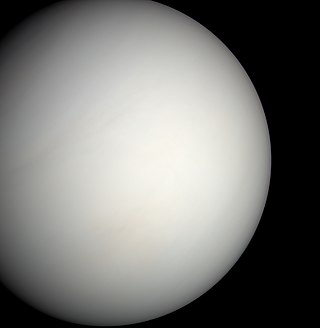
Venus is the second planet from the Sun. It is a terrestrial planet and is the closest in mass and size to its orbital neighbour Earth. Venus is notable for having the densest atmosphere of the terrestrial planets, composed mostly of carbon dioxide with a thick, global sulfuric acid cloud cover. At the surface it has a mean temperature of 737 K and a pressure of 92 times that of Earth's at sea level. These conditions are extreme enough to compress carbon dioxide into a supercritical state close to Venus's surface.

Mariner 2, an American space probe to Venus, was the first robotic space probe to report successfully from a planetary encounter. The first successful spacecraft in the NASA Mariner program, it was a simplified version of the Block I spacecraft of the Ranger program and an exact copy of Mariner 1. The missions of the Mariner 1 and 2 spacecraft are sometimes known as the Mariner R missions. Original plans called for the probes to be launched on the Atlas-Centaur, but serious developmental problems with that vehicle forced a switch to the much smaller Agena B second stage. As such, the design of the Mariner R vehicles was greatly simplified. Far less instrumentation was carried than on the Soviet Venera probes of this period—for example, forgoing a TV camera—as the Atlas-Agena B had only half as much lift capacity as the Soviet 8K78 booster. The Mariner 2 spacecraft was launched from Cape Canaveral on August 27, 1962, and passed as close as 34,773 kilometers (21,607 mi) to Venus on December 14, 1962.

Exosquad is an animated television series created by Universal Cartoon Studios for MCA TV's Universal Family Network syndicated programming block. The show is set in the beginning of the 22nd century and covers the interplanetary war between humanity and Neosapiens, a fictional race artificially created as workers/slaves for the Terrans. The narrative generally follows Able Squad, an elite Terran unit of exoframe pilots, on their missions all over the Solar System, although other storylines are also abundant. The series ran for two complete seasons in syndication from 1993 to 1994. Reruns later aired on USA Network.
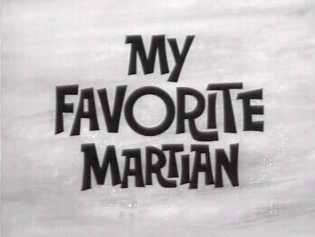
My Favorite Martian is an American sitcom that aired on CBS from September 29, 1963, to May 1, 1966, for 107 episodes. The show stars Ray Walston as "Uncle Martin" and Bill Bixby as Tim O'Hara. The first two seasons, totaling 75 episodes, were in black and white, and the 32 episodes of the third and final season were filmed in color.
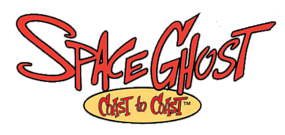
Space Ghost Coast to Coast is an American adult animated comedy late-night talk show created by Mike Lazzo for Cartoon Network and hosted by a re-imagined version of the 1960s Hanna-Barbera cartoon character Space Ghost. It is the first TV show to be produced by Williams Street, the company to start up Adult Swim in the early 2000s. In contrast to the original 1960s series, Space Ghost, which aired as a standard Hanna-Barbera Saturday-morning superhero cartoon, Space Ghost Coast to Coast is a reboot and sequel of the series intended for teens and adults, reinterpreted as a surreal spoof talk show and animated using the original series' artwork. Early seasons are more of a parody of late-night talk shows, while later seasons rely more on surrealism and non-sequitur humor.
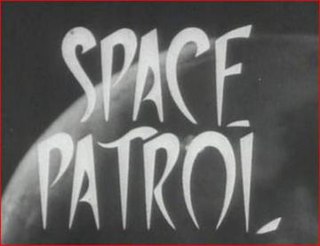
Space Patrol is a British science-fiction television series featuring marionettes that was produced in 1962 and broadcast from the beginning of April 1963. It was written and produced by Roberta Leigh in association with ABC Weekend TV.

Men Into Space is an American black-and-white science fiction television series, produced by Ziv Television Programs, Inc., that was first broadcast by CBS from September 30, 1959, to September 7, 1960. The series depicts future efforts by the United States Air Force to explore and develop outer space. The series' star, William Lundigan, played Col. Edward McCauley.
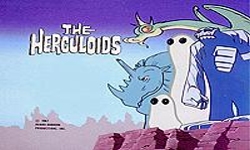
The Herculoids is an American Saturday-morning animated-cartoon television series, created and designed by Alex Toth, that was produced by Hanna-Barbera Productions. The show debuted on September 9, 1967, on CBS. Hanna-Barbera produced one season for the original airing of the show, although the original 18 episodes were rerun during the 1968–69 television season, with The Herculoids ending its run on September 6, 1969. Eleven new episodes were produced in 1981 as part of the Space Stars show. The plotlines are rooted in science fiction and fantasy.

Colonel Bleep is a 1957 American animated TV series which was the first color cartoon series made for television. It was created and written by Robert D. Buchanan and Jack Schleh on June 8, 1956, and was animated by Soundac, Inc. of Miami. The show was originally syndicated on September 21, 1957, as a segment on Uncle Bill's TV Club. One hundred episodes, of varying length of between three and six minutes each, were produced. Of these episodes, 45 episodes are known to exist in some form, eight of which are only available in monochrome.
Syncro-Vox is a filming method that combines static images with moving images, the most common use of which is to superimpose talking lips on a photograph of a celebrity or a cartoon drawing. It is one of the most extreme examples of the cost-cutting strategy of limited animation. The method was developed by cameraman Edwin "Ted" Gillette in the 1950s in order to simulate talking animals in television commercials. Gillette filed the technique on February 4, 1952, and obtained patent #2,739,505 on March 27, 1956.

Samson & Goliath, also known as Young Samson, is an American animated television series produced by Hanna-Barbera Productions for NBC, where it debuted on September 9, 1967. Primarily sponsored by General Mills, who controlled the distribution rights through its agency Dancer Fitzgerald Sample, Samson & Goliath was retitled Young Samson in April 1968 to avoid confusion with the stop-motion Christian television series Davey and Goliath.
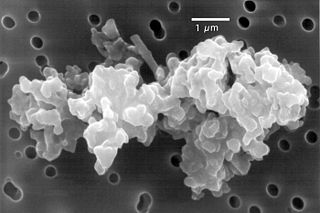
Cosmic dust – also called extraterrestrial dust, space dust, or star dust – is dust that occurs in outer space or has fallen onto Earth. Most cosmic dust particles measure between a few molecules and 0.1 mm (100 μm), such as micrometeoroids. Larger particles are called meteoroids. Cosmic dust can be further distinguished by its astronomical location: intergalactic dust, interstellar dust, interplanetary dust, and circumplanetary dust. There are several methods to obtain space dust measurement.
Super President is an American animated cartoon that aired Saturday mornings on NBC from September 16, 1967 to December 28, 1968. The series was produced by the DePatie–Freleng animation company.
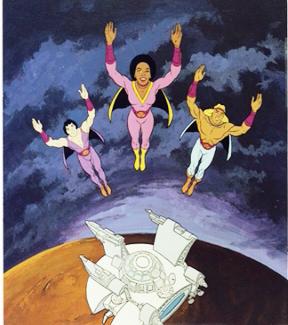
Space Sentinels is a Saturday morning animated series produced by Filmation which debuted on the American NBC network on September 10, 1977, and ran for thirteen half-hour episodes. The science fiction action series follows a superhero team during missions to protect the Earth.
Captain Fathom is an animated television series produced in 1965 by Cambria Studios. Like Cambria's other productions, Clutch Cargo and Space Angel, it was produced in Synchro-Vox. At least 26 30-minute episodes, all in color, were filmed. The episodes could be broken down into five 5-minute segments in cliffhanger format. Renowned comic book artist Alex Toth was the director.
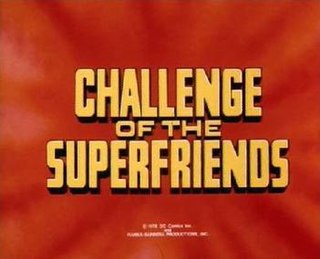
Challenge of the Superfriends is an American animated television series about a team of superheroes which ran from September 9 to December 23, 1978, on ABC. The complete series was produced by Hanna-Barbera Productions and is based on the Justice League and associated comic book characters published by DC Comics and created by Julius Schwartz, Gardner Fox and Mike Sekowsky. It was the third series of Super Friends cartoons, following the original Super Friends in 1973 and The All-New Super Friends Hour in 1977.
Space Strikers is a 1995 animated television series based on the 1870 Jules Verne novel Twenty Thousand Leagues Under the Sea. Episodes center around the crew of the spaceship Nautilus, led by Captain Nemo, in an attempt to liberate Earth and other planets from the control of Master Phantom. The series later premiered in France on M6 on March 8, 1995 and later aired in the United States on UPN from September 10 to December 3, 1995. Action sequences were shown in "Strikervision" 3-D.

Milcząca Gwiazda, literal English translation The Silent Star, is a 1960 East German/Polish color science fiction film based on the 1951 science fiction novel The Astronauts by Polish science fiction writer Stanisław Lem. It was directed by Kurt Maetzig, and stars Günther Simon, Julius Ongewe and Yoko Tani. The film was first released by Progress Film in East Germany, running 93 min. Variously dubbed and cut versions were also released in English under other titles: First Spaceship on Venus, Planet of the Dead, and Spaceship Venus Does Not Reply.
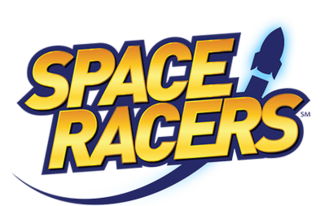
Space Racers is an American CGI preschool STEM-focused educational animated television series featuring the space travel cadets of the Stardust Space Academy. The series was produced by Space Race, LLC and co-produced by Maryland Public Television for season 1, and later WNET for seasons 2 and onward. The show began as a web series on March 22, 2011 entitled Space Race, then debuted as a television series on May 2, 2014 on select public television stations. The second season of the show debuted on October 31, 2016 on Sprout. Since the second season, the show's original production funding was provided by NASA, which involves science and space technology education, in partnerships with U.S. Space & Rocket Center and U.S. Space Camp.













